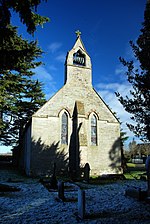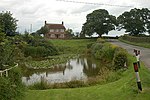Soulton Long Barrow
Barrows in EnglandBuildings and structures in ShropshireCOVID-19 pandemic monuments and memorials

The Soulton Long Barrow and Ritual Landscape is a modern memorial in the form of a long barrow in the Soulton landscape near Wem in Shropshire, England. The barrow contains niches for the placement of cremation urns. It is also intended for wider celebration of life and community activity. The structure is a sequence of stone chambers under an earthen mound, and was begun in 2017, with a principal stone being laid in the spring of 2018, and an early stone being added by writer and historian Tom Holland.
Excerpt from the Wikipedia article Soulton Long Barrow (License: CC BY-SA 3.0, Authors, Images).Soulton Long Barrow
Soulton Road,
Geographical coordinates (GPS) Address Nearby Places Show on map
Geographical coordinates (GPS)
| Latitude | Longitude |
|---|---|
| N 52.8738 ° | E -2.6786 ° |
Address
Soulton Road
Soulton Road
SY4 5RR , Wem Rural
England, United Kingdom
Open on Google Maps











